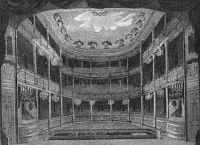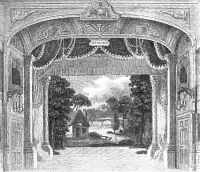The Liberty of Well Close had for its western boundary a place named Saltpetre Bank, which was swept away when Dock Street was made, and therefore included within its limits Well Street. On the east side of Well Street there are several houses still standing which, although much altered from their original state were built in the early eighteenth century.
It was because of the fact that Well Street was outside the jurisdiction of London and Middlesex that a theatre was projected wherein to give performances of the "legitimate drama," that is to say of those plays that could only be legally presented in London and Middlesex on the stages of Drury Lane and Covent Garden, which were known as the "patent theatres." This restriction, which was imposed by the Censorship Act of 1737, was not removed until 1843. The new playhouse was intended for the performance of five-act plays, in the belief that the Royal Liberty would afford them immunity from the operation of the law. In the sanguine hope of evading the consequences of their actions the promoters were encouraged to proceed in their work, despite satire and ridicule, by the necessary capital being subscribed. A correspondent in one of the public journals of the day wrote in a facetious mood as follows:
"I know no reason why the 'quality' at both ends of the Town should not have the same diversions. This will be a great ease to the Ladies of Rag Fair who are now forced to trudge as far as Lincoln's Inn Fields to mix themselves with quality. The Mumpers of Knockvargis [1] will now have a Playhouse come to them who were not able to stump it to the other end of the Town on their wooden legs."
The building of the theatre was undertaken by John Wilmot for John Palmer, the actor, formerly of Drury Lane Theatre. The first stone was laid with imposing ceremony on Monday, 26 December 1785, the inscription thereon being as follows:
"The ground selected for the purpose being situated within the Liberty of His Majesty's Fortress and Palace of the Tower of London. It has been resolved that in honour of the Magistrates and Military Officers and the Inhabitants of the said Fortress and Palace, the edifice when erected shall be called The Royalty Theatre."
This somewhat grandiose resolution suggests the patronage that was anticipated, but the support of the magistrates did not prove of much avail when the question of the power of the Lord Chamberlain was raised.
The theatre was opened on 20 June 1787 with a production of Shakespeare's comedy As You Like It, preceded by Garrick's farce Miss in Her Teens, but only one performance was given, and the profit being appropriated to the London Hospital the patentees of the two West End houses did not interfere to prevent it. They afterwards successfully appealed to the Lord Chamberlain the subject, the intention being to keep the privilege to themselves of presenting Tragedy and High Comedy. The new theatre was, therefore, closed for a short time and subsequently reopened with a licence obtained under the Act of Parliament for authorising the magistrates to grant permission for the exhibitions of interludes, pantomimes and performances of a miscellaneous character. It was here that John Braham (1774-1856), the great tenor, made his first public appearance when thirteen years old, taking the part of Cupid in a musical sketch. He wrote many songs to which his singing gave wide popularity. One of them, "The Death of Nelson," is still well known. Here, too, Clarkson Stansfield, the future Royal Academician, after leaving the sea, was employed as a scenic artist.
All kinds of subterfuges were attempted by the management to sandwich a play between the mixed items of the programme, but an actor found contravening the law by playing without a licence could be committed by an old statute passed in the reign of Elizabeth, and treated as a rogue and a vagabond. It was two years later that notice was taken of two well-known players, who were brought before the Tower magistrates sitting in the Court House in Wellclose Square. The sequel is briefly told in the following announcement:
22 May 1789. Two of the Tower Magistrates were Fined a hundred pounds each for discharging Bannister and Palmer, who had been committed as vagrants for acting plays without a licence at the Royalty.
The exterior of the theatre was of plain brick without decoration, and Dickens wrote many years later: "Of its external appearance I can only remember the loyal initials G.R. painted untidily in yellow ochre on the front." Illustrations of the interior of the theatre convey a good impression of the architecture, and are also interesting because they dispel any possible doubt concerning the style of house that was erected here at so early a date.
 The
spacious auditorium was candle-lit by ten cut-glass lustres suspended round the boxes, and the
pit, which was the best elevated in any theatre, consisted of thirteen rows extending twenty-six
feet in depth and thirty-five feet in width. The proscenium was twenty-eight feet wide and the
arch was decorated with scarlet drapery. There were little doors on either side for the players
to enter and leave in front of the curtain so that they might take their call to receive applause
without destroying the illusion on the acting stage, a practice which might well be revived
to-day.
The
spacious auditorium was candle-lit by ten cut-glass lustres suspended round the boxes, and the
pit, which was the best elevated in any theatre, consisted of thirteen rows extending twenty-six
feet in depth and thirty-five feet in width. The proscenium was twenty-eight feet wide and the
arch was decorated with scarlet drapery. There were little doors on either side for the players
to enter and leave in front of the curtain so that they might take their call to receive applause
without destroying the illusion on the acting stage, a practice which might well be revived
to-day.
It should be remembered that besides the residents in the neighbourhood, there were many seafaring persons and also country folk from the eastern counties who had come up to town and who would be temporarily staying from time to time at the numerous inns in Aldgate and Whitechapel. To these a place of honest entertainment of an elevating character was denied - such was the temper of the period. Very narrow views prevailed in one section of the community, and in 1803 a member of the Society for the Suppression of Vice issued a pamphlet entitled A Solemn Protest against the revival of Scenic Exhibitions and Interludes at the Royalty; containing remarks on Pizarro, The Stranger, and John Bull.
 After
experiencing varying fortunes, the high-styled Royalty Theatre abandoned its original and allusive
name in 1809, and became known as the East London Theatre. It was purchased in 1820 by a stage-struck
Member of Parliament, Mr. Peter Moore, whose adventure met with indifferent success. On 11 April
1826 it was burnt down, and on its site was erected within seven months another building having
a facade said to resemble that of the opera house San Carlo at Naples. This theatre, by way
of compliment to the Royal Family, was called the Brunswick Theatre. It was designed by Stedman
Whitwell, C.E., and was opened on 25 February 1828 with a version of Scott's novel, The
Bride of Lammermoor, called The Mermaiden's Well : or the Fatal Prophecy, followed
by a farce and ballet. A few days later, during the rehearsal of Guy Mannering, the
whole theatre collapsed, a dozen or more persons were killed and several seriously injured.
The catastrophe was caused by the great weight of the iron roof and the insecure wall of brick,
and again the manner of the times showed itself in the fact that the occasion was taken to preach
a sermon against theatres in general in the ruins actually before all the sufferers had been
removed.
After
experiencing varying fortunes, the high-styled Royalty Theatre abandoned its original and allusive
name in 1809, and became known as the East London Theatre. It was purchased in 1820 by a stage-struck
Member of Parliament, Mr. Peter Moore, whose adventure met with indifferent success. On 11 April
1826 it was burnt down, and on its site was erected within seven months another building having
a facade said to resemble that of the opera house San Carlo at Naples. This theatre, by way
of compliment to the Royal Family, was called the Brunswick Theatre. It was designed by Stedman
Whitwell, C.E., and was opened on 25 February 1828 with a version of Scott's novel, The
Bride of Lammermoor, called The Mermaiden's Well : or the Fatal Prophecy, followed
by a farce and ballet. A few days later, during the rehearsal of Guy Mannering, the
whole theatre collapsed, a dozen or more persons were killed and several seriously injured.
The catastrophe was caused by the great weight of the iron roof and the insecure wall of brick,
and again the manner of the times showed itself in the fact that the occasion was taken to preach
a sermon against theatres in general in the ruins actually before all the sufferers had been
removed.
A passage, named Grace's Alley, leads from Well Street into Wellclose Square, and where it enters, there stood, in the middle of the last century, Wilton's Music Hall, otherwise known as the "Old Mahogany Bar." The premises, which accommodated fifteen hundred persons, were originally intended for the presentation of a good class of entertainment, and twenty thousand pounds were spent on the building and fittings. Because of the changing population, however, it failed to attract the better sort of patronage, and degenerated into a place of a low class of amusement. It is sometimes alluded to in the worst of terms, but, the rough house that it was, many of the yarns spun around it have to be received with caution, for they are mostly exaggerated and not a few are highly-coloured inventions. One of the latter kind tells how drunken sailors, after being robbed, were sent down below through a trap-door, in Sweeney Todd fashion, for their bodies to be washed into the river. The place, nevertheless, was one of ill-repute, but perhaps no better nor any worse than many others that were to be found in seaport towns in those bad days.
In 1823, Wellclose Square saw the opening scene of the long competition for the supply of gas to the inhabitants, which spread and was continued in other parts of London. For here the Ratcliff Company, which had been so recently incorporated, began the contest first with the Imperial Company, and secondly, in 1829, with the British Company, who had acquired the interests of the former Company... Reference to this locality also calls to mind that the house (No. 6) close by in Shorter Street belongs to the Commercial Gas Company, and in it the London County Council have their testing station which is fitted up with apparatus for the use of its officers appointed to examine the quality of the gas supplied to the Company's consumers.
by Sydney Maddocks
[1] A mumper was a term applied to a canting beggar, and Knockfergus was the name borne by a section of what is now Cable Street.
